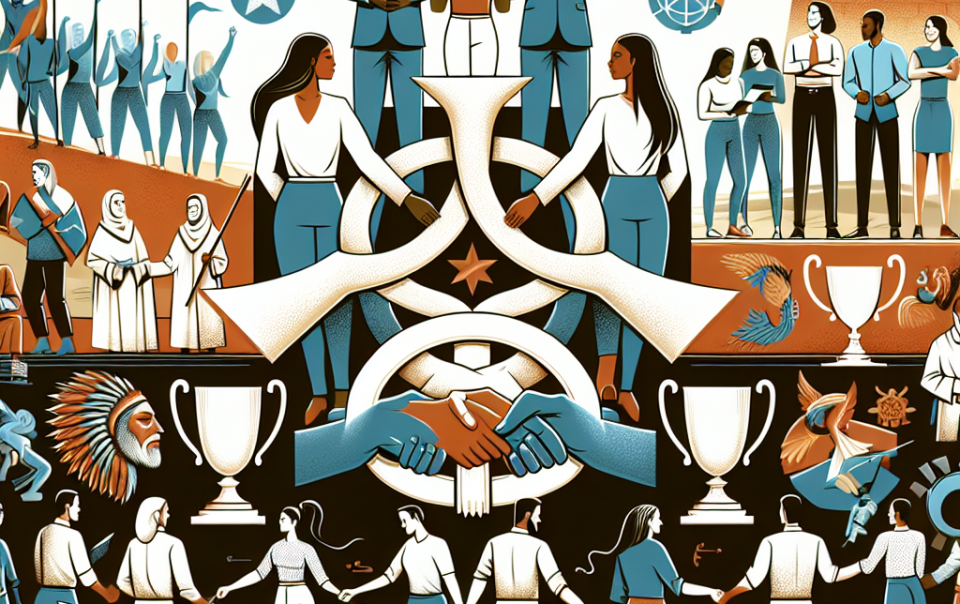
People-Centric Leadership and Brian Tracy: Unlock the Secret to Building a Caring and High-Performing Team
Understanding the Consideration Factor in Leadership
Imagine a manager who always listens first, understands your challenges, and genuinely cares about your well-being. This isn’t just a dream scenario—it’s the essence of People-Centric Leadership. Traditional leadership often focuses on tasks and results, but putting people first can transform a workplace. Leaders who prioritize consideration create environments where employees feel valued and understood, leading to higher morale and productivity.
Consider the story of Sarah, a team leader at a tech company. Instead of pushing her team to meet tight deadlines without pause, she took the time to understand their personal lives and challenges. By showing genuine concern, Sarah built a bond of trust and loyalty. Her team not only met their goals but exceeded them, demonstrating the power of a people-centered approach.
Research shows that leaders who exhibit consideration are more effective in fostering a supportive workplace. When leaders prioritize their team’s needs, they encourage open communication and collaboration. This approach not only enhances employee satisfaction but also drives organizational success. Embracing consideration as a key leadership trait can redefine how teams operate and achieve their objectives.
Building Trust through Genuine Care
Trust is the foundation of any successful team, and genuine care is the cornerstone of that trust. When leaders show authentic concern for their employees, it builds a strong sense of reliability and loyalty. Trustworthy leaders create a safe space where team members feel comfortable sharing ideas and taking risks.
Take the example of Lisa, a project manager who always checks in with her team members not just about work, but about their personal lives. By remembering birthdays, celebrating achievements, and offering support during tough times, Lisa fosters a deep sense of trust. Her team knows they can rely on her, which leads to a more cohesive and motivated group.
According to recent studies, employees who trust their leaders are more engaged and committed to their work. This trust translates into higher levels of employee well-being and lower turnover rates. Leaders who prioritize genuine care are not only building trust but also cultivating a loyal and dedicated workforce. Investing in relationships is key to long-term success and a thriving workplace.
Effective Communication and Active Listening
Communication is more than just talking; it’s about understanding and being understood. Effective leaders master the art of active listening, ensuring that their team members feel heard and valued. This two-way communication fosters a collaborative and transparent work environment.
John, a CEO of a medium-sized company, practices active listening by holding regular one-on-one meetings with his employees. During these sessions, he encourages them to share their ideas, concerns, and feedback. By truly listening, John gains valuable insights and makes informed decisions that benefit both the team and the organization.
Strong communication skills are essential for relationship-building and trust. Leaders who listen actively can address issues promptly and effectively, preventing misunderstandings and conflicts. Moreover, clear communication ensures that everyone is aligned with the company’s vision and goals. Investing time in improving communication can significantly enhance team dynamics and overall performance.
Empathy as a Core Leadership Trait
Empathy is the ability to understand and share the feelings of others. In leadership, empathy is a powerful tool that helps build strong, supportive relationships. Leaders who show empathy can connect with their team on a human level, fostering a sense of belonging and mutual respect.
Consider Maria, a department head who notices when an employee is struggling with their workload or personal issues. Instead of reprimanding them, she offers support and adjusts their responsibilities temporarily. This empathetic approach not only helps the employee navigate their challenges but also strengthens their commitment to the team.
Studies highlight that empathetic leaders contribute to a positive work environment and higher job satisfaction. Empathy encourages inclusivity and reduces workplace stress, making employees feel respected and valued. By prioritizing empathy, leaders can create a more harmonious and productive workplace where everyone thrives.
Supporting Professional and Personal Growth
A great leader invests in the growth and development of their team members. Supporting both professional and personal growth shows that leaders care about the holistic well-being of their employees. This approach not only enhances skills but also boosts morale and job satisfaction.
Emily, a team leader in a marketing firm, regularly provides opportunities for her team to attend workshops and training sessions. She also encourages them to pursue personal interests and hobbies. By supporting their growth both professionally and personally, Emily fosters a motivated and engaged team that continually strives for excellence.
Providing mentorship and resources for development is crucial for employee well-being and career advancement. Leaders who prioritize growth help their employees reach their full potential, which benefits the entire organization. Investing in your team’s growth is a win-win, driving both individual success and collective achievement.
Creating a Positive and Inclusive Work Environment
A positive and inclusive work environment is essential for fostering teamwork and innovation. Leaders who prioritize inclusivity ensure that every team member feels respected and valued, regardless of their background or role. This creates a culture where diversity thrives and everyone can contribute their best.
At a leading software company, the leadership team implemented an inclusivity program that celebrates diverse cultures and perspectives. They hold regular diversity training sessions and encourage open discussions about inclusion. This initiative has led to increased creativity and collaboration, proving that an inclusive environment enhances overall performance.
Inclusivity in leadership also means recognizing and addressing biases. By promoting an open and accepting culture, leaders can prevent discrimination and ensure equal opportunities for all employees. A positive and inclusive work environment not only attracts top talent but also retains it, driving long-term success and a harmonious workplace.
Recognizing and Valuing Employee Contributions
Recognition and appreciation are powerful motivators in the workplace. Leaders who regularly acknowledge their team’s efforts create a culture of gratitude and respect. Valuing employee contributions boosts morale and encourages continuous improvement and dedication.
Tom, a sales manager, makes it a point to celebrate his team’s achievements every month. Whether it’s through a public shout-out in meetings or a personalized thank-you note, Tom ensures that his team feels appreciated. This recognition not only lifts spirits but also inspires others to strive for excellence.
Research indicates that employees who feel valued are more engaged and loyal to their organization. Regular recognition fosters a positive atmosphere and strengthens relationship-building within the team. Leaders who prioritize acknowledgment and appreciation cultivate a motivated workforce that is committed to achieving shared goals.
Balancing Task Orientation with People Orientation
Effective leadership requires a delicate balance between focusing on tasks and caring for people. While achieving goals is important, attending to the needs and well-being of team members is equally crucial. This balance ensures that productivity and employee satisfaction go hand in hand.
Laura, a project coordinator, excels at managing deadlines and deliverables. However, she also takes time to understand her team’s challenges and provides support when needed. By balancing task orientation with people orientation, Laura ensures that her team remains productive without feeling overwhelmed or undervalued.
Finding the right balance contributes to a more sustainable and harmonious work environment. Leaders who can seamlessly integrate task management with people-centered practices create teams that are both efficient and happy. This equilibrium leads to higher performance and a more engaged workforce, driving long-term success for the organization.
Fostering Team Collaboration and Cohesion
Team collaboration and cohesion are vital for achieving collective goals. Leaders who promote a collaborative culture encourage open communication, mutual support, and shared responsibility. This fosters a sense of unity and drives the team towards common objectives.
At a renowned design agency, the leadership team implements regular brainstorming sessions and team-building activities. These initiatives encourage team members to share ideas and work together, enhancing creativity and problem-solving. As a result, the team operates smoothly and delivers outstanding results consistently.
Effective collaboration relies on strong relationship-building and trust among team members. Leaders who prioritize teamwork create an environment where everyone feels involved and empowered to contribute. This not only improves productivity but also cultivates a supportive and dynamic workplace where innovation can thrive.
Leading with Integrity and Authenticity
Integrity and authenticity are the cornerstones of trustworthy leadership. Leaders who act with honesty and uphold strong moral principles earn the respect and admiration of their team. Authentic leaders are true to themselves and transparent in their actions, fostering a culture of trust and accountability.
James, the founder of a successful startup, is known for his transparent leadership style. He openly shares the company’s challenges and successes with his team, encouraging honesty and openness. This authenticity has built a strong sense of trust and loyalty among his employees, driving the company’s growth and success.
Leaders who prioritize integrity ensure that their actions align with their words. This consistency builds credibility and sets a positive example for the entire organization. Authentic leadership inspires employees to follow suit, creating a culture where honesty and ethical behavior are highly valued. By leading with integrity, leaders lay the foundation for a resilient and trustworthy organization.
Conclusion
People-Centric Leadership isn’t just a buzzword—it’s a transformative approach that can redefine how organizations operate. By prioritizing empathy, consideration, and genuine care, leaders can build trust, foster collaboration, and create an inclusive and supportive work environment. The benefits are clear: higher employee engagement, increased loyalty, and greater overall success.
As we navigate the complexities of modern workplaces, the importance of putting people first cannot be overstated. Leaders who embrace a people-centered approach not only enhance the well-being of their employees but also drive their organizations towards sustained growth and innovation.
Are you ready to transform your leadership style and prioritize the people who make your organization thrive? Start by implementing one of these strategies today and witness the positive impact on your team and your business.
What steps will you take to become a more people-centric leader? Share your thoughts and experiences in the comments below!




